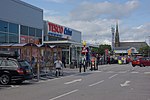Furness Building Society
1865 establishments in EnglandBanks established in 1865Building societies of EnglandCompanies based in Barrow-in-FurnessOrganizations established in 1865 ... and 1 more
United Kingdom building society stubs
Furness Building Society is a British building society, which has its headquarters in Barrow-in-Furness, Cumbria, England. Established in 1865, it is the 17th largest in the United Kingdom based on total assets of £813 million as at 31 December 2010. It is a member of the Building Societies Association. The Society expanded its call centre in 2009 to deal with investments and insurance queries. The Society has two wholly-owned subsidiary companies: Furness Mortgage Services Ltd and Furness Independent Financial Advisers. In 2017, Chris Harrison was appointed as the CEO of Furness Building Society.
Excerpt from the Wikipedia article Furness Building Society (License: CC BY-SA 3.0, Authors).Furness Building Society
Cornwallis Street,
Geographical coordinates (GPS) Address Nearby Places Show on map
Geographical coordinates (GPS)
| Latitude | Longitude |
|---|---|
| N 54.112 ° | E -3.2287 ° |
Address
Town Hall (1)
Cornwallis Street
LA14 2LJ , Hindpool
England, United Kingdom
Open on Google Maps







